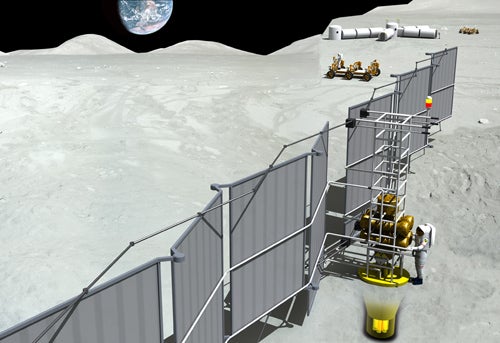Nuclear Moon Bases
NASA weighs its options for lighting up moon bases


Gone Fission
When lunar astronauts flick on their televisions after a long day of prospecting, they’ll have a trashcan-size nuclear reactor to thank for their nightly dose of prime time. NASA, looking past the already daunting task of simply getting humans to the moon by 2020, recently started considering proposals for ways to power lunar habitats. Batteries and fuel cells provide only short-term solutions. Solar power would be limited where a single night lasts as long as 354 hours. So space-agency officials have started making plans to go nuclear.
The outline for the Fission Surface Power (FSP) plan is fairly straightforward: An underground, uranium-powered nuclear reactor produces heat and drives a power converter to generate electricity. The nuke plant would churn out 40 kilowatts of electricity, enough power to provide life support to four astronauts with plenty left over to mine oxygen from lunar soil and run moon buggies.
NASA is mulling two power-converter designs. Ohio-based SunPower has offered up a pressurized-gas-and-piston Stirling engine, which is going head-to-head with a Brayton-cycle engine that heats compressed gas to spin a turbine by the Colorado company Barber-Nichols [see illustrations below]. The Stirling engine is slightly more efficient at generating electricity, but the Brayton’s proven design stands less risk of breaking down. Within the next year, the space agency will select a power converter and, for the next five years, test the unit using an electrical-resistance heater in place of the nuclear reactor.
Whichever power converter emerges victorious, FSP is perfect for the moon, says Jim Werner, the reactor project manager at the U.S. Department of Energy’s Idaho National Engineering Laboratory. With most parts moving slowly and infrequently, it should run maintenance-free for eight years, he says. “You can put it in place, turn it on, and forget about it for the duration of the mission.”
Two Options for Turning Nuclear Heat into Electricity

Stirling Convertor: More Efficient

Brayton Engine: More Reliable
_
Fission isn’t the only out-there project NASA’s working on these days. Check out the Aviation & Space winners of our Best of What’s New awards to see more.
_